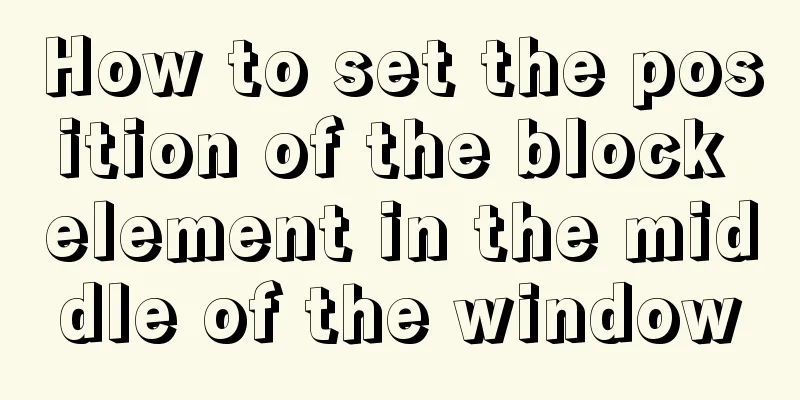Detailed explanation of Vue project optimization and packaging

PrefaceAfter the Vue project is developed, before packaging and releasing the project, an essential operation is project optimization, which is also a plus for programmers. Follow the steps of this article to see how to optimize the project~ 1. Routing lazy loading 1. Why do we need lazy loading of routes?When I just ran the project, I found that all the js files and css files were loaded as soon as I entered the page. This process was very time-consuming. If you load the corresponding js and css files of the corresponding page when you open the page, the page loading speed will be greatly improved. 2. How to implement lazy loading of routesVue official documentation: Routing lazy loading The code is as follows (example):
{
path: '/login',
component: () => import('@/views/login/index'),
hidden: true
},
Copy code 3. Magic comments in lazy loading of routesYou can customize the name of this file by specifying webpackChunkName in the comment. The code is as follows (example): components = () => import(/* webpackChunkName:"login"*/ "../component/Login.vue") Copy code 2. Analyze the package size 1. DemandI want to know the size of each file in the packaged file. So that we can analyze and optimize the code. 2. How to generate package analysis filesRun npm run preview – --report in the terminal. This command will perform dependency analysis from our entry point main.js and analyze the size of each package. Finally, a report.html file will be generated in the generated dist folder. After opening it, you can see the space occupied by the files used in our project. (The effect diagram is as follows:)
3. Webpack configuration excludes packaging 1. DemandExclude some infrequently used packages from the generated package files. For example, xsxl.js and element.js shown in the figure above can be excluded from the generated files. 2. Exclude packagingFind vue.config.js and add the externals item as follows: The code is as follows (example):
configureWebpack: {
//Configure the title of the single page application page name: name,
externals: {
/**
* externals object attribute parsing.
* Basic format:
* 'Package name': 'The name introduced in the project'
*
*/
'vue': 'Vue',
'element-ui': 'ElementUI',
'xlsx': 'XLSX'
},
resolve: {
alias: {
'@': resolve('src')
}
}
}
Copy codeIV. Citing online resources 1. DemandAfter we performed the previous step, the package generated was much smaller. However, without these dependent packages, the project cannot be run online. Then we need to reference resources in the network to support the operation of our code. 2. CDN The full name of CDN is “Content Delivery Network”, which is called content distribution network in Chinese. We use it to improve access speed and put some static resources: css, .js, pictures, videos on a third-party CDN server to speed up access speed. benefit:
3. Implementation stepsNote : In the development environment, file resources can still be taken from the local node_modules, and only when the project is online do you need to use external resources. At this point we can use environment variables to distinguish. The details are as follows: The code is as follows (example): In the vue.config.js file:
let externals = {}
let cdn = { css: [], js: [] }
const isProduction = process.env.NODE_ENV === 'production' // Determine whether it is a production environment if (isProduction) {
externals = {
/**
* externals object attribute analysis:
* 'Package name': 'The name introduced in the project'
*/
'vue': 'Vue',
'element-ui': 'ELEMENT',
'xlsx': 'XLSX'
}
cdn = {
css: [
'https://unpkg.com/element-ui/lib/theme-chalk/index.css' // element-ui css style sheet],
js: [
// vue must be at first!
'https://unpkg.com/[email protected]/dist/vue.js', // vuejs
'https://unpkg.com/element-ui/lib/index.js', // element-ui js
'https://cdn.jsdelivr.net/npm/[email protected]/dist/xlsx.full.min.js', // xlsx
]
}
}
Copy codewebpack configuration externals configuration items
configureWebpack: {
//Configure the title of the single page application page name: name,
externals: externals,
resolve: {
alias: {
'@': resolve('src')
}
}
}
Copy code Injected into
chainWebpack(config) {
config.plugin('preload').tap(() => [
{
rel: 'preload',
fileBlacklist: [/\.map$/, /hot-update\.js$/, /runtime\..*\.js$/],
include: 'initial'
}
])
//Inject cdn variable (will be executed when packaging)
config.plugin('html').tap(args => {
args[0].cdn = cdn // Configure cdn to the plugin return args
})
// Omit the rest...
}
Copy code Find
<head>
<meta charset="utf-8">
<meta http-equiv="X-UA-Compatible" content="IE=edge,chrome=1">
<meta name="viewport" content="width=device-width, initial-scale=1, maximum-scale=1, user-scalable=no">
<link rel="icon" href="<%= BASE_URL %>favicon.ico">
<title><%= webpackConfig.name %></title>
<!-- Import style -->
<% for(var css of htmlWebpackPlugin.options.cdn.css) { %>
<link rel="stylesheet" href="<%=css%>">
<% } %>
<!-- Import JS -->
<% for(var js of htmlWebpackPlugin.options.cdn.js) { %>
<script src="<%=js%>"></script>
<% } %>
</head>
Copy code5. Pack and remove console.log 1. DemandAfter the project is packaged and launched, remove all console.log in the code 2. Code DemonstrationConfigure in the vue.config.js file: The code is as follows (example):
chainWebpack(config) {
config.optimization.minimizer('terser').tap((args) => {
args[0].terserOptions.compress.drop_console = true
return args
})
}
SummarizeThis article ends here. I hope it can be helpful to you. I also hope you can pay more attention to more content on 123WORDPRESS.COM! You may also be interested in:
|
<<: The difference between Input's size and maxlength attributes
>>: Quickly obtain database connection information and some extensions through zabbix
Recommend
Detailed explanation of the idea of xshell remote login to CentOS7 without password login
First, let me talk about the general idea: 1. Log...
What is ZFS? Reasons to use ZFS and its features
History of ZFS The Z File System (ZFS) was develo...
Detailed steps for installing and configuring MySQL 8.0 on CentOS
Preface Here are the steps to install and configu...
Vue+flask realizes video synthesis function (drag and drop upload)
Table of contents We have written about drag and ...
Tutorial on using hyperlink tags in XHTML
Hyperlink, also called "link". Hyperlin...
JS implements the curriculum timetable applet (imitating the super curriculum timetable) and adds a custom background function
Overview: I drew lessons from several timetable s...
Docker case analysis: Building a MySQL database service
Table of contents 1 Create configuration and data...
Detailed explanation of prototypes and prototype chains in JavaScript
Table of contents Prototype chain diagram Essenti...
Teach you how to implement Vue3 Reactivity
Table of contents Preface start A little thought ...
Detailed explanation of how to use awk in Linux
Before learning awk, we should have learned sed, ...
Install MySQL 5.7.17 in win10 system
Operating system win10 MySQL is the 64-bit zip de...
How does Vue track data changes?
Table of contents background example Misconceptio...
Detailed steps for manually configuring the IP address in Linux
Table of contents 1. Enter the network card confi...
Detailed explanation of creating stored procedures and functions in mysql
Table of contents 1. Stored Procedure 1.1. Basic ...
js to realize login and registration functions
This article example shares the specific code of ...










